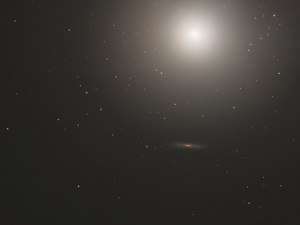Messier 89
| Galaxie Messier 89 | |
|---|---|
(c) ESA/Hubble, CC BY 4.0 | |
| Hubble-Aufnahme der elliptischen Galaxie Messier 89 | |
| AladinLite | |
| Sternbild | Jungfrau |
| Position Äquinoktium: J2000.0, Epoche: J2000.0 | |
| Rektaszension | 12h 35m 39,8s[1] |
| Deklination | +12° 33′ 23″[1] |
| Erscheinungsbild | |
| Morphologischer Typ | E;LINER;HII Sy2[1] |
| Helligkeit (visuell) | 9,9 mag[2] |
| Helligkeit (B-Band) | 10,9 mag[2] |
| Winkelausdehnung | 5,1′ × 4,7′[1] |
| Flächenhelligkeit | 12,7 mag/arcmin²[2] |
| Physikalische Daten | |
| Rotverschiebung | 0,001134 ± 0,000014[1] |
| Radialgeschwindigkeit | (340 ± 4) km/s[1] |
| Hubbledistanz H0 = 73 km/(s • Mpc) | (54 ± 12) · 106 Lj (16,472 ± 3,642) Mpc [1] |
| Durchmesser | 80.000 Lj |
| Geschichte | |
| Entdeckung | Charles Messier |
| Entdeckungsdatum | 18. März 1781 |
| Katalogbezeichnungen | |
| M 89 • NGC 4552 • UGC 7760 • PGC 41968 • CGCG 070-184 • MCG +02-32-149 • GC 3097 • h 1348 • VCC 1632 | |
Messier 89 (auch als NGC 4552 bezeichnet) ist eine elliptische Galaxie vom Hubble-Typ E im Sternbild Jungfrau auf der Ekliptik. Sie ist schätzungsweise 54 Millionen Lichtjahre von der Milchstraße entfernt, hat einen Scheibendurchmesser von etwa 80.000 Lj und ist Mitglied des Virgo-Galaxienhaufens.
M89 erscheint praktisch kreisförmig und hat in der Hubble-Sequenz den Typ E0. Allerdings wurde in den 1990er Jahren eine ausgedehnte Hülle, die sich etwa 150.000 Lichtjahre nach außen erstreckt, entdeckt. M89 war die erste Galaxie, bei der eine derartige Hülle entdeckt wurde. Zudem wurde eine jetartige Struktur entdeckt, die darauf hinweist, dass sich eine andere Galaxie im Auflösungsprozess in M89 befindet.
Im Gegensatz zur ähnlich großen Galaxie Messier 90, die nur 0,6° nördlich liegt, bewegt sie sich mit ähnlicher Geschwindigkeit von uns weg. Dies kann durch die Dynamik des sehr massereichen Virgo-Haufens erklärt werden.
Messier 89 wurde am 18. März 1781 von Charles Messier entdeckt.[3]
Literatur
- Michael König, Stefan Binnewies (2019): Bildatlas der Galaxien: Die Astrophysik hinter den Astrofotografien, Stuttgart: Kosmos, S. 199
Weblinks
Einzelnachweise
Auf dieser Seite verwendete Medien
Bildtafel der 110 Messier-Objekte. Diese Datei wird in der w:de:Template:Navigationsleiste Messierobjekte als Imagemap genutzt. Sie darf daher nicht durch eine andere Version überschrieben werden!
(c) ESA/Hubble, CC BY 4.0
Messier Monday
This huge ball of stars — around 100 billion in total — is an elliptical galaxy located some 55 million light-years away from us. Known as Messier 89, this galaxy appears to be perfectly spherical; this is unusual for elliptical galaxies, which tend to be elongated ellipsoids. The apparently spherical nature of Messier 89 could, however, be a trick of perspective, and be caused by its orientation relative to the Earth.
Messier 89 is slightly smaller than the Milky Way, but has a few interesting features that stretch far out into the surrounding space. One structure of gas and dust extends up to 150 000 light-years out from the galaxy’s centre, which is known to house a supermassive black hole. Jets of heated particles reach out to 100 000 light-years from the galaxy, suggesting that Messier 89 may have once been far more active — perhaps an active quasar or radio galaxy — than it is now. It is also surrounded by an extensive system of shells and plumes, which may have been caused by past mergers with smaller galaxies — and implies that Messier 89 as we know it may have formed in the relatively recent past.
Messier 89 was discovered by astronomer Charles Messier in 1781, when Messier had been cataloguing astronomical objects for 23 years — ever since he mistook a faint object in the sky for Halley’s Comet. Upon closer inspection, he realised the object was actually the Crab Nebula. To prevent other astronomers from making the same error, he decided to catalogue all the bright, deep-sky objects that could potentially be mistaken for comets. His methodical observations of the night sky led to the first comprehensive catalogue of astronomical objects: the Messier catalogue! Messier 89 holds the record for being the last ever giant elliptical to be found by Messier, and the most perfectly spherical galaxy in the entire catalogue of 110 objects.
Credit:
ESA/Hubble & NASA, S. Faber et al.
Coordinates Position (RA): 12 35 40.87 Position (Dec): 12° 34' 1.26" Field of view: 2.37 x 1.78 arcminutes Orientation: North is 129.5° left of vertical Colours & filters Band Wavelength Telescope Optical V 555 nm Hubble Space Telescope WFPC2 Optical I 814 nm Hubble Space Telescope WFPC2.



